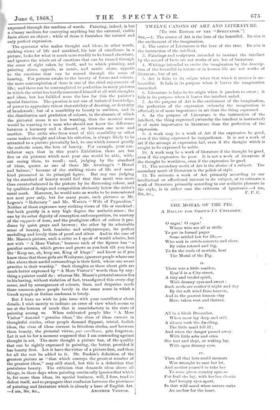TWELVE CANONS OF ART AND LITERATURE. [To THE EDITOR OF
THE "SPECTATOR."
SIR,-1. The source of Art is the love of the beautiful. Its aim is the excitement of the imagination.
2. The source of Literature is the love of the true. Its aim is the instruction of the intellect.
3. Paintings and sculptures intended to instruct the intellect by the record of facts are not works of art, but of literature.
4. Writings intended to excite the imagination by the descrip- tion of the beautiful in nature or iu human life are not works of literature, but of art.
5. Art is false to its origin when that which it creates is uu- beautiful. It fails in its purpose when it leaves the imagination unexcited.
6. Literature is false to its origin when it panders to error ; it fails in its purpose when it leaves the intellect unfed.
7. As the purpose of Art is the excitement of the imagination, the perfection of the expression (whereby the imagination is affected) is of more importance in art than the thing expressed.
8. As the purpose of Literature is the instruction of the intellect, the thing expressed (whereby the intellect is instructed) is of more importance in literature than the perfection of the expression.
9. A work may be a work of Art if the expression be good, even if the thing expressed be insignificant. It is not a work of art if the attempt at expression fail, even if the thought which is sought to be expressed be noble.
10. A work may be a work of literature if the thought be good, even if the expression be poor. It is not a work of literature if the thought be worthless, even if the expression be good.
11. The secondary merit of Art is the choice of a subject. The secondary merit of literature is the polish of style.
12. To estimate a work of Art primarily according to our intellectual or affectional interest in its subject, or to estimate a work of literature primarily according to our aesthetic pleasure in the style, is in either case the criticism of ignorance.—I am,


































 Previous page
Previous page